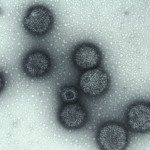Link to Pubmed [PMID] – 18477708
J. Antimicrob. Chemother. 2008 Sep;62(3):484-9
OBJECTIVES: The aim of this study was to analyse the emergence of carbapenem resistance among hospital strains of Acinetobacter in the Czech Republic.
METHODS: Acinetobacter isolates were collected prospectively in 2005-06 from 19 diagnostic laboratories. They were identified to species level by AFLP, typed using AFLP, pulsed-field gel electrophoresis (PFGE) and multilocus sequence typing, and tested for susceptibility to 14 antimicrobials and for the presence of 20 genes associated with antimicrobial resistance.
RESULTS: A total of 150 Acinetobacter isolates were obtained from 56 intensive care units of 20 hospitals in 15 cities. They were identified as Acinetobacter baumannii (n = 108) or other species. A. baumannii isolates were allocated to EU clone I (n = 5), EU clone II (n = 66) or other, mostly unique genotypes. Two-thirds of the clone II isolates had nearly identical AFLP and PFGE fingerprints. As many as 85% and 88% isolates were susceptible to meropenem and imipenem (or=8 mg/L were found in 23 A. baumannii isolates, of which 20 belonged to clone II. Isolates with bla(OXA-58-like) (n = 3)(,) bla(OXA-24-like) (n = 1) or ISAba1 adjacent to bla(OXA-51-like) (n = 34) had carbapenem MICs of 2 to >16 mg/L, while those without these elements showed MICs of <or=0.5-4 mg/L. Clone II isolates varied in susceptibility to some antibiotics including carbapenems and carried 6-12 resistance genes in 17 combinations.
CONCLUSIONS: The emergence of Acinetobacter carbapenem resistance in the Czech Republic is associated with the spread of A. baumannii strains of EU clone II. The variation in susceptibility in these strains is likely to result from both the horizontal spread of resistance genes and differential expression of intrinsic genes.

